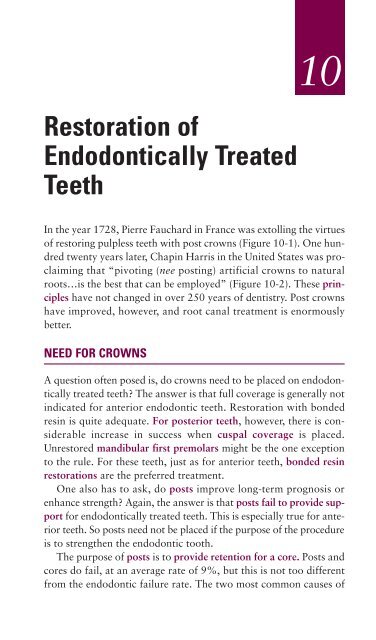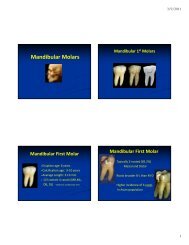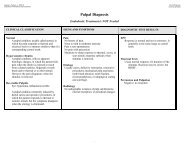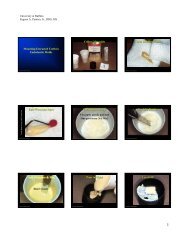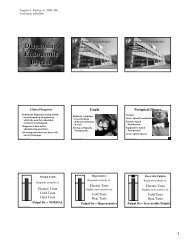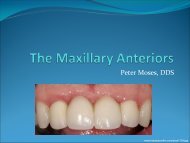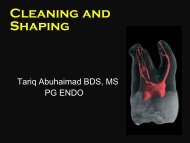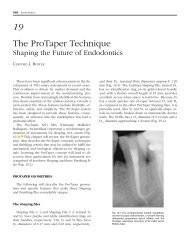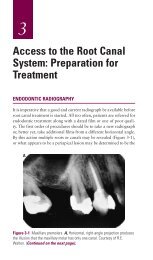Ch10: RESTORATION OF ENDODONTICALLY TREATED TEETH
Ch10: RESTORATION OF ENDODONTICALLY TREATED TEETH
Ch10: RESTORATION OF ENDODONTICALLY TREATED TEETH
Create successful ePaper yourself
Turn your PDF publications into a flip-book with our unique Google optimized e-Paper software.
Restoration of<br />
Endodontically Treated<br />
Teeth<br />
In the year 1728, Pierre Fauchard in France was extolling the virtues<br />
of restoring pulpless teeth with post crowns (Figure 10-1). One hundred<br />
twenty years later, Chapin Harris in the United States was proclaiming<br />
that “pivoting (nee posting) artificial crowns to natural<br />
roots…is the best that can be employed” (Figure 10-2). These principles<br />
have not changed in over 250 years of dentistry. Post crowns<br />
have improved, however, and root canal treatment is enormously<br />
better.<br />
NEED FOR CROWNS<br />
10<br />
A question often posed is, do crowns need to be placed on endodontically<br />
treated teeth? The answer is that full coverage is generally not<br />
indicated for anterior endodontic teeth. Restoration with bonded<br />
resin is quite adequate. For posterior teeth, however, there is considerable<br />
increase in success when cuspal coverage is placed.<br />
Unrestored mandibular first premolars might be the one exception<br />
to the rule. For these teeth, just as for anterior teeth, bonded resin<br />
restorations are the preferred treatment.<br />
One also has to ask, do posts improve long-term prognosis or<br />
enhance strength? Again, the answer is that posts fail to provide support<br />
for endodontically treated teeth. This is especially true for anterior<br />
teeth. So posts need not be placed if the purpose of the procedure<br />
is to strengthen the endodontic tooth.<br />
The purpose of posts is to provide retention for a core. Posts and<br />
cores do fail, at an average rate of 9%, but this is not too different<br />
from the endodontic failure rate. The two most common causes of
262 PDQ ENDODONTICS<br />
Figure 10-1 Fauchard’s description, in the year 1728, of his attempts to restore<br />
single and multiple units. A, “Pivot tooth,” consisting of a crown, post, and<br />
assembled unit. B, Six-unit anterior bridge “pivoted” in pulpless lateral incisors<br />
with the canines cantilevered. Crowns were fashioned from a diversity of materials:<br />
human, hippopotamus, and ox teeth, as well as ivory and leg bones. Posts<br />
were precious metal and were fastened to the crown with a sticky mastic.<br />
Nothing was said about treating the root canals before “cementation.”<br />
post failure are loss of retention and tooth fracture (Figure 10-3).<br />
Posts bend and loosen or bend and fracture. However, posts that are<br />
too short, do not fit the canal and lose retention, or are far too large<br />
for the thin walls of dentin are much more apt to cause loosening<br />
and even root fracture.<br />
POST DESIGN<br />
What, then, are the best post designs? What designs ensure the most<br />
retention? It turns out, as one might suspect, that threaded posts are
Restoration of Endodontically Treated Teeth 263<br />
Figure 10-2 One hundred twenty years after Fauchard, Tomes, in England, was<br />
advocating a more sophisticated form of post-and-crown construction.<br />
Principles used today in selecting post length and diameter were taught by<br />
practitioners in the mid-1800s.<br />
the most retentive and tapered posts are the least retentive. However,<br />
threaded posts produce the greatest potential for root fracture.<br />
Threaded posts that cut their own threads into the dentin are the most<br />
threatening, even when the post is a split post. Threaded posts that<br />
fit into counterthreads prepared in the dentin are less threatening.<br />
Parallel-sided posts with serrations are more retentive than are smoothsided<br />
parallel posts, and if they fit well in the canal, they are the least<br />
likely to cause fracture. Posts that do not fit well and “float in a sea<br />
of cement” gradually lose retention. Also, caries attack the root facing<br />
if the post loosens and allows space to develop under the core.
264 PDQ ENDODONTICS<br />
Figure 10-3 Fractured maxillary first premolar caused by a post with excessive<br />
diameter and insufficient length.<br />
POST LENGTH<br />
The rule of thumb for the proper length for a post is three-quarters<br />
the length of the root when treating long-rooted teeth. When an average<br />
root length is encountered, post length should be dictated by<br />
retaining 5 mm of apical gutta-percha and extending the post to<br />
the gutta-percha (Figure 10-4A). In curved roots the post should terminate<br />
at the point where substantive curvature begins. Posts too<br />
short are not retentive enough to withstand the forces of mastication<br />
(Figure 10-4B), and posts too gross do not increase retention<br />
and they materially weaken the tooth, leading to root fracture (Figure<br />
10-5). Post diameter should not exceed one-third of the root diameter.<br />
Laboratory testing and clinical observation have led to the conclusion<br />
that 4 to 5 mm of gutta-percha should remain in the apical<br />
canal, 5 mm being preferable (see Figure 10-4A). It makes no difference<br />
if gutta-percha is removed at the time of canal filling completion<br />
or at a subsequent appointment. When 5 mm of gutta-percha<br />
is retained, a rotary and/or heated instrument appears to be acceptable<br />
in removing the excess gutta-percha.
A<br />
B<br />
Restoration of Endodontically Treated Teeth 265<br />
Figure 10-4 A, Five millimeters of gutta-percha root filling were retained in<br />
the maxillary premolar with a post extended to that point. B, Very short post in<br />
the distal root of the first molar has loosened and caused prosthesis failure.<br />
To avoid perforations and because of their familiarity with the<br />
canal direction and size, endodontists are now being asked more frequently<br />
to prepare post space and even to cement the post to place.<br />
In doing so the endodontist is assuming part of the risk in the eventual<br />
failure of the case. It is therefore imperative that one knows well
266 PDQ ENDODONTICS<br />
Figure 10-5 The excessive post diameter in the maxillary second premolar created<br />
a perforation in the mesial root concavity. Note the distinct border and<br />
round shape of the radiolucent lesion, a characteristic form indicative of root<br />
perforation.<br />
the capabilities of the referring dentist and has a definite understanding<br />
of the type of post to be placed. One caveat is that silver<br />
point fillings should be removed and replaced with adequately condensed<br />
gutta-percha.<br />
FERRULES<br />
As stated above, one of the principal causes of failure is root fracture.<br />
A principal factor in preventing root fracture is the placement<br />
of a cervical ferrule, a circumferential band of metal that surrounds<br />
the neck of the preparation. Two types of ferrules can be constructed:<br />
ferrules that are part of the post, that is, cast metal ferrules, and<br />
those that are part of the crown. It has been found that ferrules<br />
formed as part of the post are less effective than ferrules created when<br />
the overlying crown engages the tooth structure. In short, crown ferrules<br />
are more effective than post ferrules. It has also been noted that<br />
ferrules that grasp a larger amount of tooth structure are more effective<br />
than those that engage only a small amount of tooth structure<br />
(Figure 10-6).
Restoration of Endodontically Treated Teeth 267<br />
Figure 10-6 Excellent example of a crown ferrule that is extensive enough to<br />
strengthen the post crown in place. Courtesy of A.L. Frank.
268 PDQ ENDODONTICS<br />
TYPE <strong>OF</strong> POST AND CORE<br />
Posts or dowels can generally be classified as cemented/bonded posts<br />
and threaded posts. For retention, cemented posts depend on their<br />
close proximity to the dentin walls and the cementing medium used.<br />
Variations are custom-made (cast) posts and cores, and prefabricated<br />
posts, either tapered, smooth metal posts (Figure 10-7A) or<br />
parallel-sided metal posts (Para-Post, Coltene/Whaledent, Mahwah,<br />
NJ) (Figure 10-7B). Other than metal posts there are also ceramic<br />
posts made of zirconium dioxide, posts made of carbon fibers and<br />
reinforced polymers, and white fiberglass/composite posts that do<br />
not show through translucent crowns (White C-I posts, Parkell Co.,<br />
Farmingdale, NY) (Figure 10-8).<br />
There are two types of threaded posts: (1) tapered, self-threading<br />
posts, that is, posts that are screwed into the dentin that cut their<br />
own threads into the dentin (Figure 10-7C); and (2) posts that thread<br />
into pretapped counterthreads prepared in the dentin (Kurer posts,<br />
Figure 10-7D). In addition, there are tapered, finely threaded posts<br />
(Figure 10-7E) and tapered, coarsely threaded “split” posts (Figure<br />
10-9).<br />
Figure 10-7 Prefabricated post designs. A, Tapered, smooth. B, Parallel, serrated.<br />
C, Tapered, self-threading. D, Parallel, threaded. Note that the post fits<br />
into pretapped threads cut into the dentin. E, Parallel, serrated, tapered end.
Restoration of Endodontically Treated Teeth 269<br />
Figure 10-8 White C-I glass fiber/composite post (Parkell Co.) that does not<br />
show through metal-free translucent crowns.<br />
Figure 10-9 Flexi Post (EDS Co.).<br />
Note the “split” in the apical portion<br />
of the post that permits some flexion<br />
during placement.
270 PDQ ENDODONTICS<br />
Most of these threaded posts stress the dentin because they screw<br />
into it, much as a wood screw can stress and split wood. The least<br />
threatening of all these threaded posts is the Kurer post because it<br />
does not stress the dentin. For Kurer posts the counterthreads are<br />
“tapped” into the dentin with a special instrument, and the threads<br />
of the post fit like a bolt into a nut, not like a screw into wood. In<br />
contrast, tapered, threaded posts add additional stress on root structure,<br />
and tapered, split posts have not been shown to provide any<br />
advantage over nonsplit types.<br />
PREPARATION <strong>OF</strong> A POST AND CORE<br />
For illustration, one type of post-and-core restoration is outlined<br />
here: the metal, parallel, serrated Para-Post (Figure 10-10). It is<br />
assumed that the root canal filling has been completed.<br />
First the coronal tooth preparation is done (Figure 10-11A). The<br />
amount of tooth structure that needs to be removed is related to<br />
Figure 10-10 Para-Post (Coltene/Whaledent) is a parallel-sided, vented, serrated<br />
post (right). The canal is enlarged with a Peeso reamer (left), and the final<br />
channel preparation is made with a matched twist drill (center).
Restoration of Endodontically Treated Teeth 271<br />
Figure 10-11 Placement of the parallel-sided Para-Post (Coltene/Whaledent)<br />
and composite resin core in an anterior tooth. A, Endodontic treatment completed.<br />
B, Gutta-percha removed. C, Post space formed with Peeso drill. D,<br />
Post space refined with Para-Post twist drill. E, Trial placement of the post. F,<br />
Shortening the post so it does not interfere with occlusal closure but with<br />
space for fabrication of the core. The post is cemented after shortening. G, The<br />
tooth is etched and the bonded-composite core is formed and shaped with<br />
rotary instruments.<br />
the type of crown to be placed. The chamfer for the ferrule is established.<br />
If some of the tooth structure is very thin, it is best to remove<br />
it and replace it with the core material.<br />
Pulp Chamber Preparation<br />
The best time to prepare the post space is when the root canal filling<br />
is completed. For this, Peeso drills and a twist drill matched to<br />
the size of the post to be placed are used (see Figure 10-10). First the<br />
extra gutta-percha is removed with a warm plugger (Figure 10-11B).<br />
Remember, 5 mm of gutta-percha is to be left in the apical area, so<br />
any removal instruments should have a rubber stop placed so as not<br />
to exceed this depth. Next advancing sizes of Peeso drills are used in<br />
a slow-speed handpiece until the required depth is reached and the<br />
dentin walls are enlarged to near the size of the post to be placed<br />
(Figure 10-11C). Then the Para-Post twist drill the same size of the<br />
post that is to follow is used to refine the space (Figure 10-11D).
272 PDQ ENDODONTICS<br />
Next is the trial placement of the post to verify approximation without<br />
binding (Figure 10-11E). It should be measured or radiographed<br />
to make sure it is at full depth, that is, up against the remaining guttapercha.<br />
The post should then be shortened so that it does not interfere<br />
with closure and there will be enough space for the fabrication<br />
of the crown (Figure 10-11F). Before it is cemented to place, it has<br />
been suggested that the smear layer be removed from the dentin walls<br />
with a rinse of NaOCl and MTAD (ProRoot MTAD, Dentsply/Tulsa<br />
Dental). Finally, the post is cemented to place and the core is built<br />
up to receive the final restoration (Figure 10-11G).<br />
OVERDENTURES<br />
In 1789 George Washington’s first lower denture, constructed of<br />
ivory by John Greenwood, was in part supported by a left mandibular<br />
premolar. In 1969 Lord and Teel coined the term “overdenture”<br />
and described the combined endodontic-periodontic-prosthodontic<br />
technique applied thereto. 1 The concept of retaining roots in the alveolar<br />
process is based on the proven observation that as long as the<br />
root remains, the bone surrounding it remains (Figure 10-12). This<br />
Figure 10-12 Overdenture abutment,<br />
well obturated and restored with<br />
amalgam. Note the excellent bony<br />
support. Courtesy of D.H. Wands.
Restoration of Endodontically Treated Teeth 273<br />
overcomes the age-old prosthetic problem of ridge resorption (Figure<br />
10-13). Ideally, retaining four teeth, two molars and two canines,<br />
one each at the four divergent points of the arch, should provide<br />
good balance and long life to a full overdenture (Figure 10-14).<br />
If the abutment teeth are reduced to a short, rounded or bullet<br />
shape—literally tucking the abutment inside the denture base—the<br />
crown-root ratio of the tooth is vastly improved, especially for periodontally<br />
involved teeth that have lost some bone support (Figure<br />
10-15).<br />
Figure 10-13 Dramatic demonstration of alveolar bone remaining around<br />
retained canines but badly resorbed under a full upper and a posterior lower<br />
partial. Courtesy of J.L. Lord and S. Teel.<br />
Figure 10-14 Four retained abutments providing ideal support for an overdenture.<br />
Courtesy of A.A. Brewer and R.M. Morrow.
274 PDQ ENDODONTICS<br />
Figure 10-15 Mandibular canines that have served as overdenture abutments<br />
for years. Courtesy of A. Fenton and A.A. Brewer.<br />
It goes without saying that root canal treatment is necessary for<br />
these abutment teeth. The crowns of the teeth are amputated 3 to 4<br />
mm above the gingival level. The length of the remaining tooth is<br />
accurately established, and the pulps are removed. The canals are<br />
then cleaned and shaped, the smear layer is removed, and the canals<br />
are obturated with sealer and gutta-percha. Next the coronal 3 to<br />
5 mm of the gutta-percha filling is removed, the preparation is undercut,<br />
and an amalgam filling is placed with bonded sealer<br />
(AmalgamBond, Parkell Co., Farmingdale, NY).<br />
The abutments should then be properly bullet shaped with a slope<br />
back from the labial aspect to accommodate the denture tooth to be<br />
set above it. The abutments must not be too short or tissue will grow<br />
over them as “lawn grows over a sidewalk.” The abutments, tooth,<br />
and amalgam are then highly polished. When the denture is ready<br />
to be seated, it is relieved over the abutment areas, and a small amount<br />
of self-curing acrylic is placed in the relieved areas (Figure 10-16).<br />
This ensures a perfect fit over the abutments.
OVERDENTURE PROBLEMS<br />
Restoration of Endodontically Treated Teeth 275<br />
Figure 10-16 Soft, self-curing acrylic fills the depression prepared in the denture<br />
to receive the abutment. This may be replaced whenever necessary.<br />
Most overdenture problems relate to poor patient care. Patients who<br />
have been neglectful of their teeth throughout their lifetime can hardly<br />
be considered prime candidates for the good hygiene in the future.<br />
Recall appointments and bathing the teeth with sodium fluoride can<br />
be of some help. After all, two or four abutments should not be too<br />
hard to keep clean.<br />
Another problem is retention. Fortunately, there is a solution to<br />
the retention problem. The Locator Overdenture Attachment (Zest<br />
Anchors, Escondido, CA) has emerged as a remarkably clever solution<br />
to this age-old problem. The self-locating design allows patients<br />
to easily seat their overdenture. The post of the female attachment<br />
that fits in the endodontic tooth comes in three designs: a straight<br />
post and 10° and 20° posts to accommodate divergent roots (Figure<br />
10-17). 2 The Locator Attachment is a parallel post that is notched<br />
for retention. It has a length of 6 mm but can be shortened to as little<br />
as 3 mm. It is stainless steel with a titanium nitride coating and is<br />
passively cemented in place, not threaded or screwed into the root.
276 PDQ ENDODONTICS<br />
A B<br />
Figure 10-17 A, Locator Overdenture Attachments (Zest Anchors). Female<br />
attachments to be cemented into endodontically treated teeth: 0° (left); 10°<br />
(center); 20° (right). B, Illustration of how verticality and parallelism can be<br />
achieved with a 20° female attachment in a tooth abutment with divergent roots.<br />
The canal is first prepared with a Locator pilot drill to the selected<br />
depth. This is followed by a countersink diamond bur that forms<br />
a shallow recessed seat in the flat root surface. At least 1.5 mm of<br />
the female attachment must rise above the gingival crest to allow the<br />
male component in the denture to snap into place. The combined<br />
Locator attachment connection rises only 2.5 mm above the root<br />
face (Figure 10-18). 3<br />
Figure 10-18 Four Locator Overdenture Attachments (Zest Anchors) ensure<br />
adequate retention for a mandibular full denture. Courtesy of A.L. Schneider.
Restoration of Endodontically Treated Teeth 277<br />
The male attachment, which is processed in the denture, is stainless<br />
steel and is fitted with a nylon insert that allows the metal cap<br />
to pivot up to 7° without contacting the surface of the root. This<br />
allows some flexibility in the denture movement, which allows the<br />
patient to easily self-align the denture over the attachments and snap<br />
it into position (Figure 10-19). The nylon insert snaps into the female<br />
attachment much like a clothes “gripper” or, as the British call it, a<br />
press-stud. The nylon inserts also come in three strengths: 2.3 kg (5<br />
lb.) for strong retention, 1.4 kg (3 lb.) for medium retention, and 0.7<br />
kg (1.5 lb.) for light retention. When it comes to removing the denture,<br />
older or arthritic patients may find the light retention easier<br />
to manage. Husky males may prefer to have strong retention inserts.<br />
As the nylon inserts wear, they may easily be pried from position and<br />
a fresh insert snapped to place.<br />
Locator attachments are also made for osseointegrated implant<br />
overdentures.<br />
A B C<br />
Figure 10-19 The male Locator Overdenture Attachment (Zest Anchors),<br />
which is implanted in the denture, is stainless steel with a snap-in plastic<br />
insert that, in turn, snaps into the female attachment below. A, The male<br />
attachment moving into place. B, The attachment positioned over the female<br />
receptacle. C, The male attachment snapped into place. When the plastic<br />
inserts wear, they may be pried out of the attachment and replaced with new<br />
nylon inserts. The plastic allows movement in the denture.
278 PDQ ENDODONTICS<br />
REFERENCES<br />
1. Lord JL, Teel S. The overdenture. Dent Clin North Am 1969;13:871.<br />
2. Pavlatos J. The root-supported overdenture using the Locator overdenture<br />
attachment. Gen Dent 2002;Sept./Oct:448.<br />
3. Schneider AL. The use of self-aligning, low-maintenance overdenture attachment.<br />
Dent Today 2000;19.


